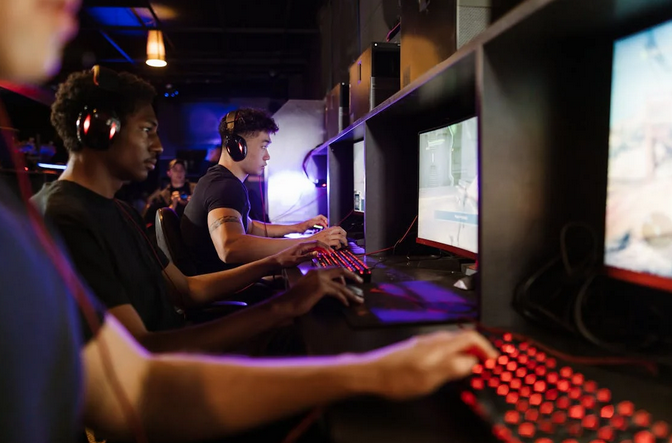The Thrill and Danger of High-Stakes Betting: What You Need to Know
High-stakes betting has a magnetic appeal for many gamblers. The excitement of large sums, intense competition, and rapid decision-making can create unforgettable experiences. Yet this thrill comes with significant risks. High-stakes games amplify both rewards and potential losses. Understanding the dynamics, psychological effects, and strategies behind these bets is crucial for anyone considering this level of gambling. This article explores the unique balance between exhilaration and danger in high-stakes betting.
The Allure of High-Stakes Betting
High-stakes betting attracts players seeking adrenaline and the possibility of substantial winnings. The larger the wager, the greater the sense of achievement when successful. For some, the thrill is unmatched and becomes a form of entertainment in itself. The excitement of a high-pressure environment can be intoxicating. Many are drawn to the energy, social dynamics, and prestige that often accompany these games.
The Role of Strategy

Strategy becomes increasingly important as the stakes rise. In games like poker or blackjack, careful planning and decision-making can influence outcomes. Skilled players analyze odds, read opponents, and manage risk to improve their chances. Even in luck-driven games, strategic bankroll management ensures players can withstand losing streaks. Applying well-thought-out strategies is essential for sustainable high-stakes play.
The Psychological Impact
High-stakes betting can produce intense emotional responses. Winning large amounts triggers euphoria, while losing can provoke stress, frustration, or even despair. Emotional swings affect decision-making, sometimes leading to impulsive bets. Players must remain self-aware and disciplined to avoid irrational choices. Understanding the psychological impact of high-stakes games is crucial for maintaining control and enjoyment.
The Social Dimension
High-stakes games often involve social interaction, creating a unique dynamic. Players compete with friends, acquaintances, or strangers, adding pressure and excitement. Networking and reputation can influence the experience. This social element can enhance enjoyment but also contribute to risk-taking behavior. Balancing social engagement with personal limits is important for a safe and rewarding experience.
Games That Typically Involve High Stakes
Not all games lend themselves to high-stakes betting. Poker, blackjack, and sports betting are among the most common. These games often combine skill and strategy with chance, making them appealing to experienced players. Slot machines and roulette can also see high stakes, though outcomes rely mostly on luck. Choosing the right game requires understanding both personal strengths and the role of randomness.
Financial Risks and Considerations

The financial risks of high-stakes betting are significant. Losses can accumulate quickly, especially without proper bankroll management. Players should set limits and avoid wagering money they cannot afford to lose. Responsible gambling involves planning, monitoring expenditures, and maintaining realistic expectations. Recognizing the potential for financial strain ensures that the thrill does not turn into a serious problem.
Signs of Problem Gambling
High-stakes betting can become addictive for some individuals. Frequent chasing of losses, neglecting responsibilities, or gambling beyond means are warning signs. Recognizing these behaviors early is vital. Support groups, counseling, and self-imposed limits can help maintain a healthy relationship with gambling. Awareness ensures that betting remains a controlled form of entertainment rather than a harmful habit.
Tips for Safe High-Stakes Play
To enjoy high-stakes betting responsibly, set clear limits for time and money. Avoid emotional decision-making and stick to strategies. Educate yourself about the games, understand probabilities, and maintain balance with other aspects of life. Regular breaks, reflection on losses and wins, and self-awareness all contribute …
















 One of the most significant red flags indicating a problematic gambling pattern is the compulsion to chase losses. If you continually increase your bets to recoup previous losses, it indicates that your gambling behavior might be getting out of control. Chasing losses rarely leads to positive outcomes and can lead to further financial strain and emotional distress. Even though you may be betting through a
One of the most significant red flags indicating a problematic gambling pattern is the compulsion to chase losses. If you continually increase your bets to recoup previous losses, it indicates that your gambling behavior might be getting out of control. Chasing losses rarely leads to positive outcomes and can lead to further financial strain and emotional distress. Even though you may be betting through a 
 Problematic
Problematic 
 Live casino gaming is one of the hottest trends in online gambling right now. Live dealer casinos offer a more realistic and immersive experience compared to traditional online casinos, where all games are run by software. The live streaming technology used in these platforms gives players real-time interaction with croupiers, allowing them to take part in interactive conversations while playing their favorite games. Players can even talk to the croupier through a chat window and feel like they are in a physical casino.
Live casino gaming is one of the hottest trends in online gambling right now. Live dealer casinos offer a more realistic and immersive experience compared to traditional online casinos, where all games are run by software. The live streaming technology used in these platforms gives players real-time interaction with croupiers, allowing them to take part in interactive conversations while playing their favorite games. Players can even talk to the croupier through a chat window and feel like they are in a physical casino.
 Last but not least, Artificial intelligence (AI) technology is being used in online gambling more and more these days. AI-enabled chatbots can provide players with personalized advice and create a more engaging gambling experience. AI can also be used to analyze player behavior and give them tailored suggestions, such as which games they should play or what bonuses they should take advantage of. AI can also be used to ensure players gamble responsibly and don’t get in over their heads with their bets.
Last but not least, Artificial intelligence (AI) technology is being used in online gambling more and more these days. AI-enabled chatbots can provide players with personalized advice and create a more engaging gambling experience. AI can also be used to analyze player behavior and give them tailored suggestions, such as which games they should play or what bonuses they should take advantage of. AI can also be used to ensure players gamble responsibly and don’t get in over their heads with their bets.

 The last winning strategy to consider is to avoid parlays. Parlay bets are when multiple bets are combined into a single wager, and the returns can be substantial if all of your picks come in. However, they are very risky, as one incorrect prediction can wipe out your entire stake. If you want to get the most out of your sports betting, it’s best to avoid making parlay bets, as there is a much higher chance of losing your money. Instead, focus on single outcomes and increase your profit chances. There may not be as much of a payout, but at least you will have the assurance that your stake won’t disappear in one fell swoop.
The last winning strategy to consider is to avoid parlays. Parlay bets are when multiple bets are combined into a single wager, and the returns can be substantial if all of your picks come in. However, they are very risky, as one incorrect prediction can wipe out your entire stake. If you want to get the most out of your sports betting, it’s best to avoid making parlay bets, as there is a much higher chance of losing your money. Instead, focus on single outcomes and increase your profit chances. There may not be as much of a payout, but at least you will have the assurance that your stake won’t disappear in one fell swoop.





 One of the biggest advantages of UFA Slot is its high payout rate. With a return-to-player percentage of over 96%, your chances of winning are much higher than in other online casino games. This means that you can enjoy longer gaming sessions, giving you more opportunities to win big.
One of the biggest advantages of UFA Slot is its high payout rate. With a return-to-player percentage of over 96%, your chances of winning are much higher than in other online casino games. This means that you can enjoy longer gaming sessions, giving you more opportunities to win big.
 Most, if not all, gamblers will agree that money is always a crucial concern, as most people gamble intending to make more cash. Although this is the case, most casinos are pretty expensive, which is one of the main reasons some people do not gamble. You may be happy to learn that online gambling platforms are cheaper than you may think.
Most, if not all, gamblers will agree that money is always a crucial concern, as most people gamble intending to make more cash. Although this is the case, most casinos are pretty expensive, which is one of the main reasons some people do not gamble. You may be happy to learn that online gambling platforms are cheaper than you may think. The second reason online gambling is suitable for you is that it is convenient in so many ways. You do not have to worry about following the many rules that traditional casinos usually set with online gambling. You may be surprised to learn that traditional casinos have rules on dress codes, drinking, and the number of bets one can make.
The second reason online gambling is suitable for you is that it is convenient in so many ways. You do not have to worry about following the many rules that traditional casinos usually set with online gambling. You may be surprised to learn that traditional casinos have rules on dress codes, drinking, and the number of bets one can make. If you are one of the many people who gamble for fun, you are guaranteed to love online gambling. Online gambling has been credited for being a source of entertainment for many people during the lock-down due to the Coronavirus outbreak.
If you are one of the many people who gamble for fun, you are guaranteed to love online gambling. Online gambling has been credited for being a source of entertainment for many people during the lock-down due to the Coronavirus outbreak.
 We live in the era of digital data and communication. You can find multiple details about sports events, players, and teams. This information is resourceful if you want to minimize your chances of losing bets. You learn more about sports participants: What they bring to the table and a team’s overall performance. This data comes in handy when calculating the probability of how matches will end.
We live in the era of digital data and communication. You can find multiple details about sports events, players, and teams. This information is resourceful if you want to minimize your chances of losing bets. You learn more about sports participants: What they bring to the table and a team’s overall performance. This data comes in handy when calculating the probability of how matches will end. If you prefer single bets, you should research the teams and players. Gather as much information as you can. From this data, try to weigh the probability of either participant winning. Many people assume if a team or player performs well for a certain period, they maintain this performance. Nonetheless, this is far from true since players get injured, and coaches change tactics from time to time.
If you prefer single bets, you should research the teams and players. Gather as much information as you can. From this data, try to weigh the probability of either participant winning. Many people assume if a team or player performs well for a certain period, they maintain this performance. Nonetheless, this is far from true since players get injured, and coaches change tactics from time to time. 

 The number one golden rule of gambling is; you should place a bet that you can afford to lose. Just like the players in the field, you need to be disciplined even when you lose. Never be tempted to place big bets to recover back what you have already lost. A high chance of losing again by using this strategy is very high. Most amateur bettors make mistakes by chasing losses. No the other hand, it is an added advantage to the bookmakers of making money. You are advised to practice patience while building your funds gradually by placing smaller but safe bets.
The number one golden rule of gambling is; you should place a bet that you can afford to lose. Just like the players in the field, you need to be disciplined even when you lose. Never be tempted to place big bets to recover back what you have already lost. A high chance of losing again by using this strategy is very high. Most amateur bettors make mistakes by chasing losses. No the other hand, it is an added advantage to the bookmakers of making money. You are advised to practice patience while building your funds gradually by placing smaller but safe bets. Very few gamblers keep their betting record. If you are always betting with different bookmakers, you must keep your record to determine whether you are making losses or profit. It can also help you to identify the type of bet which is of an advantage to you. Gambling on football is not a winning game always. If all gamblers win every time, bookmarkers will close their business, and football gambling will no longer exist. But, by using the above tips, chances of losing will be minimized.…
Very few gamblers keep their betting record. If you are always betting with different bookmakers, you must keep your record to determine whether you are making losses or profit. It can also help you to identify the type of bet which is of an advantage to you. Gambling on football is not a winning game always. If all gamblers win every time, bookmarkers will close their business, and football gambling will no longer exist. But, by using the above tips, chances of losing will be minimized.…

 Withdrawal Options
Withdrawal Options
 To all gamers, the most important reason to engage in a game is winning, and an excellent online gaming platform should offer rewards so that you can win more. While choosing a gaming site, it is essential that you compare their bonuses and see the one that has the most generous offers. Some gaming site can even offer you a nice bonus on your first cash deposit or just registering.
To all gamers, the most important reason to engage in a game is winning, and an excellent online gaming platform should offer rewards so that you can win more. While choosing a gaming site, it is essential that you compare their bonuses and see the one that has the most generous offers. Some gaming site can even offer you a nice bonus on your first cash deposit or just registering. Different people love different type of games, and an online casino may not have all the games that you can find in your local casino. Therefore, it is essential that you see the games that are offered in a site before registering. Nevertheless, you will be glad to know that you can enjoy almost all of your favorite games on a single platform. What to do is find the best gaming site, and your favorite games will be available for you.
Different people love different type of games, and an online casino may not have all the games that you can find in your local casino. Therefore, it is essential that you see the games that are offered in a site before registering. Nevertheless, you will be glad to know that you can enjoy almost all of your favorite games on a single platform. What to do is find the best gaming site, and your favorite games will be available for you.
 you when you win than the good reputation, legitimate online casinos. You can register accidentally with such rogue casino that you may not be able to withdraw money when you win. If you are new to online casinos and you want to make your first deposit, deposit in small bits to first test the casino. Online casinos can have attractive bonuses meant to attract new players to make more deposits. Such casinos can offer up 300 percent to 500 percent matching bonus when you first deposit. If they are rouge, then you will have no chances of withdrawing the money no matter how much bonuses they offer. Do not make deposits of the large amount before knowing your chances of successful withdrawal.
you when you win than the good reputation, legitimate online casinos. You can register accidentally with such rogue casino that you may not be able to withdraw money when you win. If you are new to online casinos and you want to make your first deposit, deposit in small bits to first test the casino. Online casinos can have attractive bonuses meant to attract new players to make more deposits. Such casinos can offer up 300 percent to 500 percent matching bonus when you first deposit. If they are rouge, then you will have no chances of withdrawing the money no matter how much bonuses they offer. Do not make deposits of the large amount before knowing your chances of successful withdrawal. Greedy behavior is another main factor that makes players lose. When they win, they always want to win more, but whenever they lose, they try to win back the losses in the next games. That is why both losers and winners stay at the casino until all is lost before they quit. Do not be greedy to bet wildly when you lose and win. It is important to follow this rule always.…
Greedy behavior is another main factor that makes players lose. When they win, they always want to win more, but whenever they lose, they try to win back the losses in the next games. That is why both losers and winners stay at the casino until all is lost before they quit. Do not be greedy to bet wildly when you lose and win. It is important to follow this rule always.…

 Your event can be more attractive if you allow the guests to use real money to purchase fake money for use during the party. You can lease these from the casino rentals. You can choose to offer the guests drinks as a goodwill gesture when the event ends. All the reals money is collected at the end of the event and taken to the fund.
Your event can be more attractive if you allow the guests to use real money to purchase fake money for use during the party. You can lease these from the casino rentals. You can choose to offer the guests drinks as a goodwill gesture when the event ends. All the reals money is collected at the end of the event and taken to the fund.